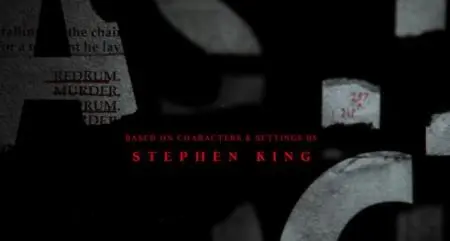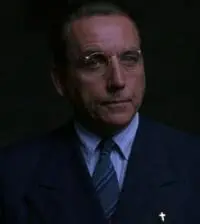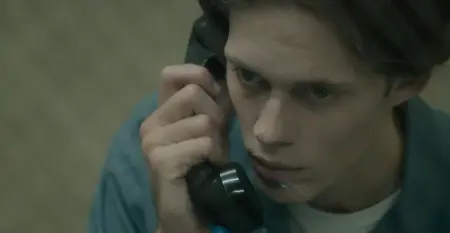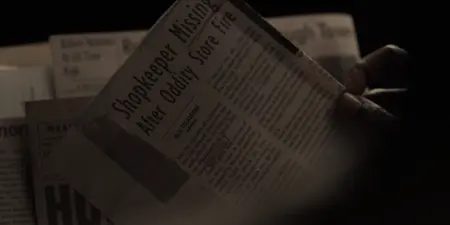Warning: SPOILERS run freer than the waters of Castle River below.
AV Club writer Drew Grant accurately predicted that the new Hulu series Castle Rock, created by Sam Shaw and Dustin Thomason, and executive produced by J.J. Abrams, would meld together both the cinematic and literary Stephen King universes based on the opening credits alone. There certainly are a tremendous amount of Easter eggs included in the sequence, but just how much these seemingly unrelated shout-outs to King's previous works and film adaptations would impact the series' narrative, Grant could not have known. But even beyond the most obvious references (It, The Shining), Castle Rock takes a pretty deep dive into the minutiae of King's world, which may have left a few of the uninitiated a bit confused by the season finale.
If that's the case (or if you just want a good walk down Stephen King trivia lane) here is a breakdown of the major references to both his literary and cinematic universes, listed in chronological order of publication/release. There are several minor references to King's works, including Misery, The Tommyknockers, and Dolores Claiborne, among others, but for the purposes of brevity, we'll stick to the core works that play a significant role in the series' plot. Other articles around the web have meticulously catalogued these references, most notably the aforementioned AV Club article on the opening credits, as well as a second article from the site on the references contained within each of the series' episodes. Likewise, I've included some, but not all, of King's own Easter eggs pertaining to Castle Rock in his writing. He mentions the town as recently as his latest novel Elevation, but I'm only concerning myself with the major references.
"Carrie"
There are virtually no references to King's first novel in Castle Rock (though there are some fun literary connections related to "The Body," see below). The only major nod to Carrie comes in the form of Sissy Spacek, who of course played the titular telekinetic girl in Brian de Palma's 1976 adaptation. She portrays Ruth Deaver in the series, (adopted) mother to series protagonist Henry Deaver (André Holland and Bill Skarsgård—yes, there are two Henry Deavers) and longtime romantic partner of ex-sheriff Alan Pangborn (played by Scott Glenn; more on him and his relationship with Ruth below).
"The Shining"
It would be impossible to create a series that serves as a love letter to Stephen King without including nods to one of his most famous works. At first glance, it might seem that Castle Rock's incorporation of Jack Torrance and his lapse into alcohol-withdrawal-fueled insanity—by way of an "overlooked" niece (Janet Levy), who changed her name to Jackie as a tribute to her psychotic uncle—is a bit sloppy and played mostly for winking laughs. But when you look a bit closer, you see that something quite strange is going on, something that speaks to the series' unique position of blending the literary with the cinematic.
Let's hold on a discussion of Jackie Torrance for a moment and start with the opening credits sequence. We see references to "REDRUM" and room 217 via the torn pages direct from King novels. But we also see something curious: the phrase "All work and no play makes Jack a dull boy" also appears, a line Jack Torrance writes over and over again on his typewriter in Stanley Kubrick's adaptation (which King notoriously loathes). This phrase does not appear in the novel. This combined with the depiction of Wendy Torrance as a battered and terrified wife, a hedge maze substituting for moving hedge animals, and the moving of room 217 about twenty doors down, to room 237, represent the most major changes Kubrick made to the original text.
And speaking of this room number change, we see a nod to this represented in the opening credits as well: the "mysterious note-taker," as AV Club writer Drew Grant calls them, has marked out the number 217 and written, in red ink—as thought it were a correction to a mistake—237.
This, in many ways, is an inside joke, a means of commenting on just how influential Kubrick's film is in popular consciousness, able to eclipse King's novel entirely. The show's creators take this a step further with the murder-obsessed Jackie Torrance, who ultimately kills a man in self-defense using an axe rather than a croquet mallet. And yet, the act of taking a life seems to change Jackie; she states to the police, concerning the killing, in a far-off, awed sort of way, "I wasn't myself anymore, you know?" We see little else of her until the finale, when she seems back to her usual, quasi-goofy self, while also unveiling her plans to write an autobiography of all the violence in her life. She tells Dean Merrill (more on him below) that she's going to "head west" and finish her story where it all started—which, we infer, will be at the Overlook Hotel.
Again, this may seem like goofy Shining winking, but when you think about her dazed and dreamy reaction to killing another human being, and the fact she's deliberately heading into the hornet's nest, so to speak (the deeply haunted Overlook), one imagines that Jack's story will repeat itself all over again through Jackie—that is, a more-or-less normal individual having their dark side exploited and magnified by malevolent spirits. And this future narrative for Jackie is all King and no Kubrick, since in the latter's film, Jack seems crazy and evil from the very beginning, rather than an average man torn apart by demons both internal and external.
"The Dead Zone"
The first King story set in Castle Rock, The Dead Zone concerns Johnny Smith, a man who, after lying in a coma for five years, awakens with the ability to see into the future. While the TV series' writers make no reference to Johnny, they do make several allusions to one of the novel's subplots, involving a serial strangler named Frank Dodd (also a deputy with the Castle Rock Police Department). In King's book, Johnny uses his precognitive powers to help Sheriff George Bannerman solve the crimes, resulting in Dodd killing himself inside his mother's home.
In the series, the recently deceased Shawshank Penitentiary warden Dale Lacey (Terry O'Quinn) asks the audience (during a voice over narration) if they "remember the dog, and the strangler," as he recalls some of the town's past horrors. While the "dog" references Cujo (see below), the "strangler" here is undoubtedly Dodd, especially when considering that Dodd's past crimes show up twice more in the series.
The first is a bit loose, admittedly, and more a reference to Needful Things (see below), but town realtor and psychic "shiner" Molly Strand (Melanie Lynskey) insists that "every revitalized downtown needs a gazebo." Dodd kills one of his victims on a gazebo (or at least, what David Cronenberg reinterpreted as a gazebo in his 1983 film adaptation of the novel; in King's work, it's a bandstand). Johnny also visits this structure, and receives a psychic flash of the killer there, ousting Deputy Dodd.
Last but not least, Molly also tells prospective buyers of one her properties that a serial strangler died in her house, and she sleeps like a baby, indicating she lives in Dodd's mother's old house, where the killer ended his life.
"Cujo"
The aforementioned "remember the dog" line represents the first reference in the series to this King work. The second comes in the form of a newspaper clipping, discovered by series protagonist Henry Deaver (André Holland) in Warden Lacey's basement. The headline: "Rabid Dog Tears Through Town," with the proceeding article highlighting some of the plot points from the novel, including the death of Sheriff George Bannerman, whom Cujo mauls (and whose passing opens the door for Alan Pangborn to take the job, but, again, more on him later).
The article also points out that four-year old Tad Trenton also fell victim to the rabid dog's terror, leaning on the King literary universe, rather than the cinematic one; in the film version of Cujo, Tad survives, a happy ending countering King's original, in which the boy dies of dehydration from being trapped by Cujo in a too-hot, broken down car with his mother, Donna.
"The Dark Tower Series"
Rather than list every single Dark Tower novel individually, let's lump them together here. (Chronologically speaking, the first in the series, The Gunslinger, arrives here, between Cujo and Different Seasons.)
Concerning King's broad bibliography, all roads almost inevitably lead back to The Dark Tower, but for the most part, screen adaptations of his work serve as standalone stories, unconnected to the larger literary universe (the recent Dark Tower film notwithstanding, because we don't like to talk about that). Castle Rock firmly roots itself in King's literary and cinematic territory, however, and that means The Dark Tower is present and accounted for. SlashFilm writer Jacob Knight offers what was, at the time of his article's publication, a theory that the show connects to King's sprawling dark fantasy series via the "schisma," a strange noise in the woods surrounding Castle Rock that Henry's (adopted) father, the Reverend Matthew Deaver (Adam Rothenberg), believes is the voice of God. However, Odin (CJ Jones), one of the reverend's disciples, has a more scientific theory about the schisma. As Knight explains:
Schisma is what he labels 'nanoscale psychoacoustics,' that can be heard more intensely depending on the geographic location of the individual. Depending on how loud the schisma is, the specific spot is operating closer in parallel to a companion version of itself. In layman's terms, it means that there are 'other heres, other nows.' 'All possible pasts, and all possible presents,' Odin continues, 'schisma is the sound of these places trying to reconcile themselves.'
Knight theorizes that the schisma represents the location where reality touches Midworld, the parallel universe where much of The Dark Tower takes place. In Castle Rock's ninth episode, we learn that Knight's theory is correct, although not strictly in relation to Midworld, but rather, all worlds. The schisma is indeed a doorway traversing long distances, parallel universes, alternate timelines, and different realities, which allows the two Henrys to swap places and cause all kinds of mayhem in their respective versions of their hometowns.
Considering that the series affirms there are multiple timelines of Castle Rock, this helps to explain the merging of King's literary and cinematic universes—according to the show creators, Kubrick's version of The Shining is simply an alternate timeline, where Jack Torrance used an axe instead of a croquet mallet—and also explains the inconsistencies with and total absence of certain characters prominent in King's original Castle Rock universe (see Needful Things below).
''Rita Hayworth and Shawshank Redemption'' ('Different Seasons')
Significant action takes place in this titular penitentiary, most notably the discovery of The Kid AKA the other Henry Deaver (Bill Skarsgård) imprisoned below the surface of the prison proper, inside an old water tank. However, all other references to Shawshank revolve more around the film adaptation than King's novella. Specifically, a guard at Shawshank points out the bullet hole where Warden Norton shot himself following the exposure of his crimes—a plot point that only occurs in The Shawshank Redemption; in the novella, Warden Norton simply retires in disgrace. We also see a brief glimpse of a portrait of Warden Norton, as portrayed by Bob Gunton in the aforementioned film, hanging on one of Shawshank's walls.
Finally, in the first episode, just before committing suicide himself, Warden Lacy listens to the same section of The Marriage Figaro as Andy Dufresne (Tim Robbins) enjoys in The Shawshank Redemption.
BONUS REFERENCE: It cannot be said definitively whether or not the connection is intentional, but consider the similarity between the old water tank sealing off a possible evil from the rest of the world and the subterranean pit—also seemingly sealed-off for protective purposes—in King's short story "Graveyard Shift."
''The Body'' ('Different Seasons')
Castle Rock mentions the events of "The Body" (better known as the film Stand By Me) numerous times throughout the series. Among Warden Lacey's newspaper clippings is a story about an anonymous tip leading to the discovery of Ray Brower, the titular "body" sought out by a group of boys: Gordy Lachance, Chris Chambers, Teddy DuChamp, and Vern Tessio. During one of Lacey's voiceover narrations, while telling the story of his brother's suicide, he informs the audience it "was the fall after they found that boy's body out by the train tracks."
Furthermore, we see the relatives of nearly all the bullies from the story. The first of these surname references occurs in the first episode, where we see attorney Henry Deaver (the first) defending a woman named Leanne Chambers, on trial for murdering her abusive husband, Richard Chambers. Fans of either "The Body" or Stand By Me will no doubt recognize this latter name as a member of Ace Merrill's gang, and brother to Chris Chambers, Gordy Lachance's best friend. (Given that Deaver, a native of Castle Rock, currently lives and works in Texas, it might seem a bit of a stretch that this Richard Chambers is the same man from his hometown, but as you continues with the series, you realize the names are almost certainly not a coincidence.)
Speaking of lead bully Ace Merrill, we meet one of his descendants in Castle Rock: Dean Merrill, a teenage drug dealer who sells Molly her pills, which she consumes like candy to take the edge off her "shine." Dean may or may not be the grandson of Ace, as the old bully dies in Needful Things, but might still be alive in this timeline. If not a direct descendant of Ace, Dean is certainly one in a long line of Merrills that appear throughout King's work, including Ace's uncle Reginald "Pop" Merrill, and the Merrill's from Haven, another made-up Maine town that served as the setting of The Tommyknockers (King also references Haven in several of his other works).
Last but not least, the most major appearance of a "Body" bully relative occurs in the series' fourth episode. As the first Henry digs into his past—specifically, his disappearance in 1991, of which he remembers little—he comes across a small plot of land owned by Vince Desjardins, another member of Ace's gang. Henry investigates this land, and encounters not Vince but his brother Joseph, who is, to borrow one of King's phrases from "The Body," "crazier'n a shithouse rat."
BONUS REFERENCES: As previously stated, Castle Rock barely references King's first novel Carrie (Sissy Spacek's casting aside). King rarely dipped back into this world himself, though he made a couple of references to Carrie in "The Body." First, Ray Brower was a resident of Chamberlain, where Carrie White also lived—Gordy states the town is "forty miles or so east of Castle Rock."
Second, there is a Teddy DuChamp both in Carrie and "The Body." In the latter, he is friends with Gordy, Chris, and Vern, and goes on the "adventure" to find Ray Brower's body, while in Carrie, he is the owner of Teddy's Amoco, a gas station in Chamberlain. Given the fates of both Teddys in each book, it seems unlikely they are the same character, but highly possible they are related in some way; it is even possible the Teddy DuChamp from Carrie is in fact Teddy's uncle, mentioned in "The Body" as the proprietor of the Castle Rock Stationery Shoppe, though for this to work, at some point this elder Teddy would have had to sell the stationary store, move to Chamberlain, and open up Teddy's Amoco (which is not unheard of).
And, as a bonus within the bonus, consider the (near) repetition of the surname Desjardins. Rita Desjardin (without the "s") is Carrie White's sympathetic gym teacher—could she be of the same clan, distant relatives to the Desjardinses, whose surname got bastardized somewhere along the way? Perhaps, thought it's also likely King simply forgot he used a version of the surname Desjardins in Carrie while writing "The Body."
"Pet Sematary"
By series creators Sam Shaw and Dustin Thomason's own admission, a portion of Castle Rock serves as their own "re-imagining" of Pet Sematary. The subplot concerns a "neighborhood dog" who only occasionally belongs to Ruth Deaver. The unfortunate pup gets run over by a semi-truck and buried by Alan Pangborn—except Ruth believes she keeps seeing the doggo rummaging around the property, forcing Alan to unearth the corpse to make sure it's still dead. Now, Ruth has Alzheimer's, and because of this, her timeline often becomes skewed (the episode "The Queen" takes place almost entirely from Ruth's confused point of view, and it is easily the best hour of the series). From her perspective, the dog genuinely will not stay dead.
BONUS REFERENCE: Ludlow, the setting for Pet Sematary, does not get a shoutout in the series, but King made sure to shout out Castle Rock in his novel, mentioning the events of Cujo there. And because a rabid Saint Bernard also went on a rampage in this series, it's reasonable to assume there's a Ludlow in this universe (or an alternate universe) where Ruth's neighborhood dog could actually come back from the dead.
''Mrs. Todd's Shortcut'' ("Skeleton Crew")
As previously discussed with the Dark Tower series above, there is some kind of rift or wormhole in the woods surrounding Castle Rock, which serves as a crossroads of sorts, an intersection of alternate realities, where the two Henry Deavers cross into each other's worlds. But if you're thinking the idea that Castle Rock containing an inter-dimensional crossroads is unique to this series, then you've never read "Mrs. Todd's Shortcut," one of King's Twilight Zone-esque short stories, collected in Skeleton Crew. In this tale, the titular Mrs. Todd obsesses over finding the best shortcuts in the area, leading her to discover the ultimate shortcut, one that slashes her drive time to literal unreal levels by routing her through another plane of existence altogether. King cements this shortcut as being a Dark Tower pathway with the inclusion of a strange, rodent-like creature the narrator of the tale finds attached to Mrs. Todd's grill, an animal that later appears in the third book of the Dark Tower series, The Waste Lands, where they're known as Billy-Bumblers.
"It"
References to King's 18th novel crop up throughout Castle Rock, most notably in the form of more meta-casting. Bill Skarsgård, who plays the The Kid AKA Henry Deavers, of course played Pennywise in the 2017 adaptation of It, alongside Chosen Jacobs, who played Mike in It and the first Henry Deavers's son Wendell in this series. We see Derry on the map during the opening credits, and both the Kid and a young Henry spend time at Juniper Hill, the mental facility made famous in King's novel: Henry Bowers goes there after taking the fall for the child murders committed by Pennywise (as well as the murder of his father, of which Henry is most definitely guilty).
But perhaps the most significant connection to It is the fact that the time between the first Henry Deavers's disappearance in 1991 and the discovery of The Kid down in the water tank at Shawshank is 27 years—the same period of time between Pennywise's reigns of terror over Derry. And, with the season finale, we're left to assume that, in another 27 years or so, the first Henry Deaver, having now re-imprisoned The Kid, AKA, the second Henry Deaver, will likely go down the same path as Dale Lacy and the Reverend Matthew Deaver, both of whom imprisoned young men under the pretense they were the Devil. As The Kid says to Henry, "After a while, you forget which side of the bars you're on," suggesting that the guilt and exhaustion of keeping a supposedly evil young man inside a cage will eventually take its toll on Henry, and he too will kill himself out in the woods, close to the schisma. And thus, the cycle will repeat itself—just as the cycle of It repeats itself, every 27 years.
"The Dark Half"
Aside for the fact this novel gives readers the first significant storyline involving Sheriff Alan Pangborn, there aren't many nods to The Dark Half contained within Castle Rock (this may be partially due to the fact that the book technically takes place in Ludlow). It's possible the flock of birds that appear in conjunction with the opening of the schisma might be a reference to the sparrows that play a pivotal role in The Dark Half's conclusion, though the Castle Rock birds are way too big to be sparrows.
"Needful Things"
Needful Things is significant to the series in many ways, one because it was intended to be King's final trip to Castle Rock, and as such he pretty much destroys the entire town by novel's end. But much like Church and Gage, Castle Rock wouldn't stay dead, and King did come back a few more times (most notably in "Premium Harmony," which gives us a run-down Castle Rock much like the one depicted in the series).
The novel's antagonist Leland Gaunt and his oddities shop gets a shout-out via those aforementioned newspaper clippings seen by the first Henry Deaver in Warden Lacy's basement. And like the Cujo clip, the Needful Things article faithfully recounts the explosive climax of King's novel.
While the article does not mention this, in the book, the town's gazebo (read: bandstand) blows up in the climax—which is why Molly Strand needs to replace it in her plans for a revitalized downtown.
There is one aspect of Castle Rock that differs greatly from Needful Things, however, and that aspect is Alan Pangborn. See, throughout the events of the book, Alan enjoys a pretty healthy relationship with a woman named Polly Chalmers. He eventually marries her and moves to New Hampshire. However, while in the first timeline of the series, Alan does make it out to New Hampshire for a while, it seems Polly Chalmers never existed, and Alan's one true love was Ruth Deaver, whom he returns to after his time in the Granite State. Polly does not exist in the second timeline of the series either; Pangborn still loves Ruth, and he helps her escape her deranged reverend husband and raises the second Henry with Ruth in Boston. After that, he accompanies the Alzheimer's-plagued woman to live out the rest of her days in Florida.
The point here is, this Alan Pangborn is not the same Alan Pangborn of Needful Things—he's out there somewhere, in one of the timelines accessible via the schisma, alive and happy with Polly Chalmers (yeah, this series kills off Alan Pangborn, or at least one version of him).
And that's the key: the Castle Rock of Castle Rock isn't the same Castle Rock King keeps coming back to. It's a parallel Castle Rock, quite similar to the town seen in King's books and stories, but ultimately another animal altogether. By relying on alternate realities, Shaw and Thomason afford themselves a tremendous amount of creative freedom, allowing them to do just about whatever they please within the small borders of this haunted Maine town, while still staying true to the past works and spirit of Stephen King.
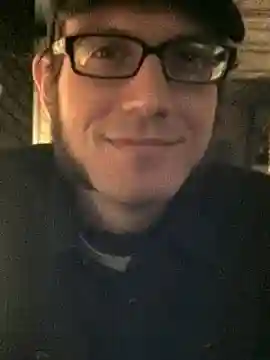
About the author
Christopher Shultz writes plays and fiction. His works have appeared at The Inkwell Theatre's Playwrights' Night, and in Pseudopod, Unnerving Magazine, Apex Magazine, freeze frame flash fiction and Grievous Angel, among other places. He has also contributed columns on books and film at LitReactor, The Cinematropolis, and Tor.com. Christopher currently lives in Oklahoma City. More info at christophershultz.com
